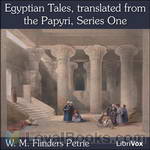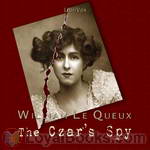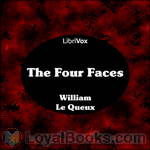|
Books Should Be Free Loyal Books Free Public Domain Audiobooks & eBook Downloads |
|
|
Books Should Be Free Loyal Books Free Public Domain Audiobooks & eBook Downloads |
|
Fiction |
|---|
|
Book type:
Sort by:
View by:
|
By: Wilhelm Hauff (1802-1827) | |
|---|---|
 The Severed Hand From "German Tales" Published by the American Publishers' Corporation
The Severed Hand From "German Tales" Published by the American Publishers' Corporation
| |
By: Grant Allen | |
|---|---|
 The Woman Who Did
The Woman Who Did
Most times, especially in the time when this book was written (1895), it is just as nature and society would wish: a man and woman “fall in love” and get married. But it is not so for Herminia Barton and Alan Merrick. They do indeed fall in love, but Herminia has a deeply held belief in freedom for women, and she holds immutable views against what she perceives as the slavery of marriage.Alan unwillingly agrees to her strong wish to remain unmarried and to live together as “close and dear friends”... | |
 The British Barbarians
The British Barbarians
After Civil Servant Philip Christy crosses paths with the mysterious Bertram Ingledew in the respectable suburb of Brackenhurst, Philip and his sister Frida, married to the wealthy Scot Robert Monteith, become friends with the stranger. Bertram has some unconventional concepts about society, and as the story unfolds, his beliefs and actions cause much disruption in the family and the neighbourhood.Who is Bertram? Where does he come from? Allen explores some interesting ideas about society, some of which are curiously relevant today... | |
 Hilda Wade, A Woman With Tenacity of Purpose
Hilda Wade, A Woman With Tenacity of Purpose
In this early detective novel, the detective is Hilda Wade. She is a very capable nurse, but there is something mysterious about her from the moment she arrives at the hospital. Upon meeting her, Dr. Hubert Cumberledge greatly admires her and becomes a devoted friend. It turns out that Hilda has one purpose in life, and in pursuit of that purpose she will travel across the world, from London to South Africa, Rhodesia, India, Nepaul, Tibet and back. With Cumberledge's support, her extraordinary logic and clear thinking lead her on through deadly perils. But will that be enough to accomplish the secret purpose which has driven her so long and so far? | |
 The Type-Writer Girl
The Type-Writer Girl
“There is no more pathetic figure in our world to-day than the common figure of the poor young lady, crushed between classes above and below, and left with scarce a chance of earning her bread with decency.” So says Juliet Appleton’s boss, encouraging her to put her story into print. How will this college-educated 23-year-old survive the Darwinian Battle of Life in late Victorian England? She’s fundless in London but armed, by way of adaptive structures, with those two high-tech devices of the day: a bicycle for mobility and a typewriter for utility. | |
 Miss Cayley's Adventures
Miss Cayley's Adventures
Fun stories of Miss Lois Cayley, independent young woman, as she, beginning with only twopence in her pocket, travels the world. | |
By: William H. Hudson | |
|---|---|
 Green Mansions: A Romance of the Tropical Forest
Green Mansions: A Romance of the Tropical Forest
“Green Mansions: A Romance of the Tropical Forest” is a narration of his life story by Abel, a Venezuelan, to a comrade. Once a wealthy young man, he meddled in politics to the extent of provoking a revolution… which failed.Escaping into the tropical forests of Guyana Abel takes up gold hunting, then journal-writing, and fails at both. Now with no aim for his life, he drifts until he takes up residence with a remote Indian tribe. Soon he learns of a wood the Indians avoid, as it is inhabited by a dangerous Daughter of the Didi, who, they say, slew one of them with magic... | |
By: W. M. Flinders Petrie | |
|---|---|
 Egyptian Tales, translated from the Papyri, Series One
Egyptian Tales, translated from the Papyri, Series One
Brief, and in some cases incomplete, stories of magic from ancient Egypt. | |
By: Edward George Bulwer-Lytton (1803-1873) | |
|---|---|
 The Coming Race
The Coming Race
Edward George Earle Lytton Bulwer-Lytton, 1st Baron Lytton (1803-1873) was an English novelist, poet, playright, and politician. Lord Lytton was a florid, popular writer of his day, who coined such phrases as “the great unwashed”, “pursuit of the almighty dollar”, “the pen is mightier than the sword”, and the infamous incipit “It was a dark and stormy night.” Despite his popularity in his heyday, today his name is known as a byword for bad writing. San Jose State University holds... | |
By: Publius Ovidius Naso | |
|---|---|
 Heroides
Heroides
The Heroides, also known as the Heroines, the Letters of the Heroines or simply as Epistles are a very famous collection of poems by Ovid, not only for their interesting subject – letters by famous mythological characters addressed to their beloved ones – but also because it’s considered by some the first example of the Epistle as a literary genre – a statement made by Ovid himself in his Ars Amatoria. The book as we have it nowadays consists of 21 letters, divided in two parts. The first... | |
By: Edith Œnone Somerville (1858-1949) | |
|---|---|
 Some Experiences of an Irish R.M.
Some Experiences of an Irish R.M.
This is the first of three novels which Edith Somerville and her cousin Violet Martin wrote about the English Major Sinclair Yates who leaves the army to take up a position of Resident Magistrate in the West of Ireland in about 1895. The tales tell in a humorous way of his struggles with a new job, new culture, and with his landlord and neighbour Mr. ‘Flurry’ Knox whose prime, if not only, interest is in hunting, which forms the background to all the stories. Miss Somerville was herself the first woman anywhere to become an M.F.H. | |
By: Charlotte Perkins Gilman (1860-1935) | |
|---|---|
 Herland
Herland
Herland is a utopian novel from 1915, written by feminist Charlotte Perkins Gilman. The book describes an isolated society comprised entirely of Aryan women who reproduce via parthenogenesis (asexual reproduction). The result is an ideal social order, free of war, conflict and domination. It first appeared as a serial in Perkin’s monthly magazine Forerunner. | |
 What Diantha Did
What Diantha Did
Charlotte Perkins Gilman opens a window of history through which we see a small part of the determined efforts made by women to elevate the circumstances of women in the early 20th century.Diantha Bell is a normal young woman desiring marriage and a home, but also she desires a challenging career in new territory that raises many eyebrows and sets malicious tongues wagging. Her effort to elevate housework and cooking to a regulated and even a scientific business, for the relief of homemakers, is a depiction of the late 19th century movement to promote Domestic Science, or Home Economics, as a means of providing more healthful home life, as well as career paths for women... | |
 The Yellow Wallpaper
The Yellow Wallpaper
| |
By: Hans Christian Andersen (1805-1875) | |
|---|---|
 What the Moon Saw: and Other Tales
What the Moon Saw: and Other Tales
| |
 A Christmas Greeting A Series of Stories
A Christmas Greeting A Series of Stories
| |
 Ice-Maiden: and Other Tales
Ice-Maiden: and Other Tales
Short-stories/fairy tales by H. C. Anderson, includes The Ice-maiden -- The Butterfly -- The Psyche -- The Snail and the Rose-treeThe Ice-Maiden: Written toward the end of Hans Christian Andersen's career, "The Ice-Maiden" is the story of Rudy, a boy who's mother died in the ice of the mountains while he survives, saved by the kiss of the Ice-Maiden. The Ice-Maiden, jealous that the boy she claimed has escaped her embrace, pursues him through the rest of his life.The Butterfly: A butterfly searches for the perfect flower to be his bride... | |
 The Sand-Hills of Jutland
The Sand-Hills of Jutland
| |
By: Winston Churchill (1871-1947) | |
|---|---|
 The Inside of the Cup
The Inside of the Cup
| |
 Coniston
Coniston
| |
 Mr. Crewe's Career
Mr. Crewe's Career
| |
 A Modern Chronicle
A Modern Chronicle
| |
 The Dwelling Place of Light
The Dwelling Place of Light
| |
By: William Le Queux (1864-1927) | |
|---|---|
 The Czar's Spy
The Czar's Spy
William Le Queux was a British novelist and prolific writer of mysteries. Indeed, mystery surrounds the author himself as to whether he was a spy or rather just a self-promoter. Regardless of which is true, Le Queux brings us a story of intrigue and espionage that travels across Europe in the true spirit of a good mystery. There are shootings, burglaries, romances, escapes from prisons, and intricate conspiracies that may surprise and leave you scratching your head as you try to solve this “whodunit”. In the best tradition of a good mystery however, you may need to wait for the final chapters to discover the truth. | |
 Hushed Up! A Mystery of London
Hushed Up! A Mystery of London
A young man, Owen Biddulph, is drawn to a beautiful young woman with a mysterious past... a past that seems to have returned to cause her disappearance! Is she his new found love or his nemesis? And who is this mysterious clergyman that warns him to avoid this young woman, at risk of his very life! What possible harm could this sweet young woman inflict? Written by one of the Masters of Mystery, William Le Queux. (Introduction by Tom Weiss) | |
 The Seven Secrets
The Seven Secrets
A true “whodunit” with as many twists and turns as an English country road. Old man Courtenay is found murdered in his bed. Dr. Ralph Boyd is summoned to Courtenay Manor to examine the slain man and discovers a clue that might solve the case. But, he decides to keep the clue private for personal reasons. In the meantime, Scotland Yard has no clues as the culprits or the motive. Dr. Boyd, because of his new found clue, is sure he knows who is the murderer. Or, is it a murderess? His intimate acquaintance, Ambler Jevons, is also investigating the crime but Dr... | |
 The Stretton Street Affair
The Stretton Street Affair
Hugh Gabriel has recently been repatriated from the war and has rejoined his old firm as an electrical engineer. On the way to visit his uncle one night, he is asked by a servant if he would be willing to meet with his wealthy master who is in some distress. Hugh becomes witness to, and directly involved with, a dastardly murder. Or has he? Who is this mysterious millionaire Oswald De Gex he has been asked to meet with? Is Doctor Moroni an honest physician or a diabolical monster? And what about... | |
 The Four Faces
The Four Faces
Michael Berrington is a bachelor leading a quiet life in London. Overhearing a conversation at his club one day, he becomes interested in a discussion regarding a man named Gastrell. Gastrell is somewhat of a mystery to the club members in spite of his renting a house from one of them. Berrington’s interest in Gastrell intensifies as his fiancé, Dulcie Challoner, befriends a wealthy widow, Mrs. Connie Stapleton who evidently has some type of relationship with Gastrell. As the plot progresses,... | |
 The Invasion
The Invasion
This novel, also known as The Invasion of 1910, is a 1906 novel written mainly by William Le Queux (with H. W. Wilson providing the naval chapters). It is one of the more famous examples of Invasion literature and is an example of pre-World War I Germanophobia, as it preached the need to prepare for war with Germany. The book takes the form of a military history and includes excerpts from the characters' journals and letters and descriptions of the fictional German campaign itself. The novel originally appeared in serial form in the Daily Mail newspaper from 19 March 1906, and was a huge success... | |
 The Sign of Silence
The Sign of Silence
Edward Royle is the head of a well-known chemical manufacturer in England, which he has inherited. He is engaged to the daughter of his father’s former partner, Phrida Shand, who lives with her mother. One night he is asked by his friend, Sir Digby Kemsley – a very famous railroad engineer, to come to his flat to discuss something although Kemsley is quite mysterious on the telephone. Royle visits, then returns home only to be summoned again by Kemsley, this time imploring him to return at once... | |
 The Minister of Evil The Secret History of Rasputin's Betrayal of Russia
The Minister of Evil The Secret History of Rasputin's Betrayal of Russia
| |
 The Doctor of Pimlico Being the Disclosure of a Great Crime
The Doctor of Pimlico Being the Disclosure of a Great Crime
| |